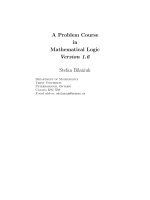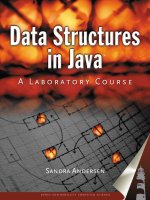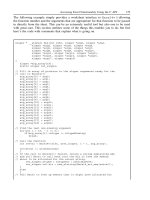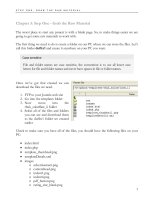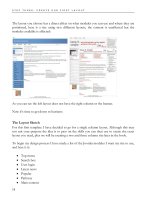A Laboratory Course in C++Data Structures phần 6 doc
Bạn đang xem bản rút gọn của tài liệu. Xem và tải ngay bản đầy đủ của tài liệu tại đây (490.9 KB, 43 trang )
Laboratory 9: Postlab Exercise 1
Doubly Linked List Implementation of the List ADT | 199
Name __________________________________________ Date _______________________
Section _________________________________________
Part A
Given a list containing N data items, develop worst-case, order-of-magnitude estimates of the
execution time of the following List ADT operations, assuming they are implemented using a
circular, doubly linked list. Briefly explain your reasoning behind each estimate.
insert O( )
Explanation:
remove O( )
Explanation:
gotoPrior O( )
Explanation:
gotoEnd O( )
Explanation:
Part B
Would these estimates be the same for an implementation of the List ADT based on a noncircular,
doubly linked list? Explain why or why not.
200 | Laboratory 9
Laboratory 9: Postlab Exercise 2
Doubly Linked List Implementation of the List ADT | 201
Name __________________________________________ Date _______________________
Section _________________________________________
Part A
Given the following arbitrarily selected—but plausible—memory requirements and a list containing
N integers, compare the amount of memory used by your singly linked list representation of the
list (Laboratory 7) with the amount of memory used by your circular, doubly linked list
representation.
Character 1 byte
Integer 2 bytes
Address (pointer) 4 bytes
Part B
Suppose the list contains N objects of class Slide (Laboratory 7, In-lab Exercise 1). Compare the
amount of memory used by your singly linked list representation of the list with the amount of
memory used by your circular, doubly linked representation.
202 | Laboratory 9
In this laboratory you will:
Examine how recursion can be used to traverse a
linked list in either direction
Use recursion to insert, delete, and move data items in
a linked list
Convert recursive routines to iterative form
Analyze why a stack is sometimes needed when
converting from recursive to iterative form
Recursion with Linked
Lists
Objectives
Overview
Recursive functions, or functions that call themselves, provide an elegant way of
describing and implementing the solutions to a wide range of problems, including
problems in mathematics, computer graphics, compiler design, and artificial
intelligence. Let’s begin by examining how you develop a recursive function definition,
using the factorial function as an example.
You can express the factorial of a positive integer n using the following iterative
formula:
n!= n и (n Ϫ 1) и (n Ϫ 2) и . . . и 1
Applying this formula to 4! yields the product 4 ϫ 3 ϫ 2 ϫ 1. If you regroup the
terms in this product as 4 ϫ (3 ϫ 2 ϫ 1) and note that 3! = 3 ϫ 2 ϫ 1, then you find
that 4! can be written as 4 ϫ (3!). You can generalize this reasoning to form the
following recursive definition of factorial:
n!= n и (n Ϫ 1)!
where 0! is defined to be 1. Applying this definition to the evaluation of 4! yields the
following sequence of computations.
4! = 4 ⋅ ( 3! )
= 4 ⋅ ( 3 ⋅ ( 2! ) )
= 4 ⋅ ( 3 ⋅ ( 2 ( 1! ) ) )
= 4 ⋅ ( 3 ⋅ ( 2 ( 1 ⋅ ( 0! ) ) ) )
= 4 ⋅ ( 3 ⋅ ( 2 ( 1 ⋅ ( 1 ) ) ) )
The first four steps in this computation are recursive, with n! being evaluated in terms
of (n Ϫ 1)!. The final step (0! = 1) is not recursive, however. The following notation
clearly distinguishes between the recursive step and the nonrecursive step (or base
case) in the definition of n!.
The following
factorial() function uses recursion to compute the factorial of a
number.
long factorial ( int n )
// Computes n! using recursion.
{
long result; // Result returned
if ( n == 0 )
result = 1; // Base case
else
result = n * factorial(n-1); // Recursive step
return result;
}
n
n
nn n
!
if (base case)
! if (recursive step)
=
=
•−
()
>
10
10
204 | Laboratory 10
Let’s look at the call factorial(4). Because 4 is not equal to 0 (the condition for
the base case), the factorial() function issues the recursive call factorial(3). The
recursive calls continue until the base case is reached—that is, until n equals 0.
factorial(4)
↓ RECURSIVE STEP
4*factorial(3)
↓ RECURSIVE STEP
3*factorial(2)
↓ RECURSIVE STEP
2*factorial(1)
↓ RECURSIVE STEP
1*factorial(0)
↓ BASE CASE
1
The calls to factorial() are evaluated in the reverse of the order they are made.
The evaluation process continues until the value 24 is returned by the call
factorial(4).
factorial(4)
↑ R
ESULT 24
4*factorial(3)
↑ R
ESULT 6
3*factorial(2)
↑ R
ESULT 2
2*factorial(1)
↑ R
ESULT 1
1*factorial(0)
↑ R
ESULT 1
1
Recursion can be used for more than numerical calculations, however. The
following pair of functions traverse a linked list, outputting the data items encountered
along the way.
template < class DT >
void List<DT>:: write () const
// Outputs the data items in a list from beginning to end. Assumes that
// objects of type DT can be output to the cout stream.
{
cout << “List : “;
writeSub(head);
cout << endl;
}
// - - - - - - - - - - - - - - - - - - - - - - - - - - - - - - - - - -
template < class DT >
void List<DT>:: writeSub ( ListNode<DT> *p ) const
// Recursive partner of the write() function. Processes the sublist
// that begins with the node pointed to by p.
Recursion with Linked Lists | 205
{
if ( p != 0 )
{
cout << p->dataItem; // Output data item
writeSub(p->next); // Continue with next node
}
}
The role of the write() function is to initiate the recursive process, which is then
carried forward by its recursive partner the writeSub() function. Calling write()
with the linked list of characters
yields the following sequence of calls and outputs “
abc”.
writeSub(head)
↓ RECURSIVE STEP
Output ‘a’ writeSub(p->next)
↓RECURSIVE STEP
Output ‘b’ writeSub(p->next)
↓RECURSIVE STEP
Output ‘c’ writeSub(p->next)
↓ BASE CASE
No output
Recursion also can be used to add nodes to a linked list. The following pair of
functions insert a data item at the end of a list.
template < class DT >
void List<DT>:: insertEnd ( const DT &newDataItem )
// Inserts newDataItem at the end of a list. Moves the cursor to
// newDataItem.
{
insertEndSub(head,newDataItem);
}
// - - - - - - - - - - - - - - - - - - - - - - - - - - - - - - - - - -
template < class DT >
void List<DT>:: insertEndSub ( ListNode<DT> *&p,
const DT &newDataItem )
// Recursive partner of the insertEnd() function. Processes the
// sublist that begins with the node pointed to by p.
{
if ( p != 0 )
insertEndSub(p->next,newDataItem); // Continue searching for
head
a
b c
206 | Laboratory 10
else // end of list
{
p = new ListNode<DT>(newDataItem,0); // Insert new node
cursor = p; // Move cursor
}
}
The insertEnd() function initiates the insertion process, with the bulk of the work
being done by its recursive partner, the insertEndSub() function. Calling
insertEnd() to insert the character ‘!’ at the end of the following list of characters:
yields the following sequence of calls.
insertEndSub(head)
↓RECURSIVE STEP
insertEndSub(p->next)
↓RECURSIVE STEP
insertEndSub(p->next)
↓RECURSIVE STEP
insertEndSub(p->next)
↓BASE CASE
Create a new node containing ‘!’
On the last call, p is null and the statement
p = new ListNode<LE>(newDataItem,0); // Insert new node
is executed to create a new node containing the character ‘!’. The address of this node
is then assigned to p. Because p is passed using call by reference, this assignment
changes the next pointer of the last node in the list (‘c’) to point to the new node,
thereby producing the following list:
Calling
insertEnd() to insert the character ‘!’ into an empty list results in a
single call to the insertEndSub() function.
insertEndSub(head)
↓RECURSIVE STEP
Create a new node containing ‘!’
head
a
b c !
head
a
b c
Recursion with Linked Lists | 207
In this case, assigning the address of the newly created node to p changes the list’s
head pointer to point to this node.
Note that the
insertEnd() function automatically links the node it creates into either
an existing list or an empty list without the use of special tests to determine whether
the insertion changes a node’s next pointer or the list’s head pointer. The key is that
parameter
p is passed using call by reference.
head
!
208 | Laboratory 10
Activities
Assigned: Check or
list exercise numbers Completed
Laboratory 10: Cover Sheet
Recursion with Linked Lists | 209
Name __________________________________________ Date _______________________
Section _________________________________________
Place a check mark in the Assigned column next to the exercises your instructor has assigned to
you. Attach this cover sheet to the front of the packet of materials you submit following the
laboratory.
Prelab Exercise
Bridge Exercise
In-lab Exercise 1
In-lab Exercise 2
In-lab Exercise 3
Postlab Exercise 1
Postlab Exercise 2
Total
Recursion with Linked Lists | 211
Name __________________________________________ Date _______________________
Section _________________________________________
We begin by examining a set of recursive functions that perform known tasks. These functions are
collected in the file listrec.cs. You can execute them using the test program in the file test10.cpp.
Part A
Step 1: To complete this laboratory, you need to use some of the functions from your singly
linked list implementation of the List ADT. Complete the partial implementation of the
List ADT in the file listrec.cs by adding the following functions from the linked list
implementation you developed in Laboratory 7:
• The constructor for the ListNode class.
• The List class constructor, destructor, insert(), clear(), and showStructure()
functions. Add any other functions that these depend on.
Prototypes for these functions are included in the declaration of the List class in the file
listrec.h. Add prototypes for any other functions as needed.
Step 2: Save the resulting implementation in the file listrec.cpp.
Step 3: Activate the calls to the write() and insertEnd() functions in the test program in the
file test10.cpp by removing the comment delimiter (and the characters ‘PA’) from the
lines beginning with “//PA”.
Step 4: Execute the write() and insertEnd() functions using the following list.
Step 5: What output does
write() produce?
head
a
b c
Step 6: What list does insertEnd() produce?
Step 7: Execute these functions using an empty list.
Step 8: What output does write() produce?
Step 9: What list does insertEnd() produce?
Part B
One of the most common reasons to use recursion with linked lists is to support
traversal of a list from its end back to its beginning. The following pair of functions
outputs each list data item twice, once as the list is traversed from beginning to end
and again as it is traversed from the end back to the beginning.
template < class DT >
void List<DT>:: writeMirror () const
// Outputs the data items in a list from beginning to end and back
// again. Assumes that objects of type DT can be output to the cout
// stream.
{
cout << “Mirror : “;
writeMirrorSub(head);
cout << endl;
}
// - - - - - - - - - - - - - - - - - - - - - - - - - - - - - - - - - -
template < class DT >
void List<DT>:: writeMirrorSub ( ListNode<DT> *p ) const
// Recursive partner of the writeMirror() function. Processes the
// sublist that begins with the node pointed to by p.
{
if ( p != 0 )
{
cout << p->dataItem; // Output data item (forward)
writeMirrorSub(p->next); // Continue with next node
cout << p->dataItem; // Output data item (backward)
}
}
212 | Laboratory 10
Step 1: Activate the call to the writeMirror() function in the test program in the
file test10.cpp by removing the comment delimiter (and the characters ‘PB’)
from the lines beginning with “//PB”.
Step 2: Execute the writeMirror() function using the following list.
Step 3: What output does
writeMirror() produce?
Step 4: Describe what each statement in the writeMirrorSub() function does
during the call in which parameter p points to the node containing ‘a’.
Step 5: What is the significance of the call to writeMirrorSub() in which
parameter p is null?
Step 6: Describe how the calls to writeMirrorSub() combine to produce the
“mirrored” output. Use a diagram to illustrate your answer.
head
a
b c
Recursion with Linked Lists | 213
Part C
The following pair of functions reverse a list by changing each node’s next pointer.
Note that the pointers are changed on the way back through the list.
template < class DT >
void List<DT>:: reverse ()
// Reverses the order of the data items in a list.
{
reverseSub(0,head);
}
// - - - - - - - - - - - - - - - - - - - - - - - - - - - - - - - - - -
template < class DT >
void List<DT>:: reverseSub ( ListNode<DT> *p, ListNode<DT> *nextP )
// Recursive partner of the reverse() function. Processes the sublist
// that begins with the node pointed to by nextP.
{
if ( nextP != 0 )
{
reverseSub(nextP,nextP->next); // Continue with next node
nextP->next = p; // Reverse link
}
else
head = p; // Move head to end of list
}
Step 1: Activate the call to the reverse() function in the test program by removing
the comment delimiter (and the characters ‘PC’) from the lines beginning with
“//PC”.
Step 2: Execute the
reverse() function using the following list.
Step 3: What list does
reverse() produce?
head
a
b c
214 | Laboratory 10
Step 4: Describe what each statement in the reverseSub() function does during the
call in which parameter p points to the node containing ‘a’. In particular, how
are the links to and from this node changed as a result of this call?
Step 5: What is the significance of the call to reverseSub() in which parameter p is
null?
Step 6: Describe how the calls to reverseSub() combine to reverse the list. Use a
diagram to illustrate your answer.
Recursion with Linked Lists | 215
Part D
In the Overview, you saw how you can use recursion in conjunction with call by
reference to insert a node at the end of a list. The following pair of functions use this
technique to delete the last node in a list.
template < class DT >
void List<DT>:: deleteEnd ()
// Deletes the data item at the end of a list. Moves the cursor to the
// beginning of the list.
{
deleteEndSub(head);
cursor = head;
}
// - - - - - - - - - - - - - - - - - - - - - - - - - - - - - - - - - -
template < class DT >
void List<DT>:: deleteEndSub ( ListNode<DT> *&p )
// Recursive partner of the deleteEnd() function. Processes the
// sublist that begins with the node pointed to by p.
{
if ( p->next != 0 )
deleteEndSub(p->next); // Continue looking for the last node
else
{
delete p; // Delete node
p = 0; // Set p (link or head) to null
}
}
Step 1: Activate the call to the deleteEnd() function in the test program by
removing the comment delimiter (and the characters ‘PD’) from the lines
beginning with “//PD”.
Step 2: Execute the deleteEnd() function using the following list.
Step 3: What list does
deleteEnd() produce?
head
a
b c
216 | Laboratory 10
Step 4: What is the significance of the calls to the deleteEndSub() function in
which p->next is not null?
Step 5: Describe what each statement in deleteEndSub() does during the call in
which p->next is null. Use a diagram to illustrate your answer.
Step 6: What list does deleteEnd() produce when called with a list containing one
data item? Describe how this result is accomplished. Use a diagram to
illustrate your answer.
Recursion with Linked Lists | 217
Part E
The following pair of functions determine the length of a list. These functions do not
simply count nodes as they move through the list from beginning to end (as an
iterative function would). Instead, they use a recursive definition of length in which
the length of the list pointed to by pointer p is the length of the list pointed to by
p->next (the remaining nodes in the list) plus one (the node pointed to by p).
template < class DT >
int List<DT>:: getLength () const
// Returns the number of data items in a list.
{
return getLengthSub(head);
}
// - - - - - - - - - - - - - - - - - - - - - - - - - - - - - - - - - -
template < class DT >
int List<DT>:: getLengthSub ( ListNode<DT> *p ) const
// Recursive partner of the getLength() function. Processes the sublist
// that begins with the node pointed to by p.
{
int result; // Result returned
if ( p == 0 )
result = 0; // End of list reached
else
result = ( getLengthSub(p->next) + 1 ); // Number of nodes after
// this one + 1
return result;
}
Step 1: Activate the call to the getLength() function in the test program by
removing the comment delimiter (and the characters ‘PE’) from the lines
beginning with “//PE”.
Step 2: Execute the getLength() function using the following list.
head
a
b c
length p
if p = 0 (base case)
length(p->next) if p (recursive step)
()
=
+≠
0
10
218 | Laboratory 10
Step 3: What result does getLength() produce?
Step 4: What is the significance of the call to the getLengthSub() function in
which parameter p is null?
Step 5: Describe how the calls to getLengthSub() combine to return the length of
the list. Use a diagram to illustrate your answer.
Step 6: What value does the getLength() function return when called with an
empty list? Describe how this value is computed. Use a diagram to illustrate
your answer.
Recursion with Linked Lists | 219
Laboratory 10: Bridge Exercise
220 | Laboratory 10
Name __________________________________________ Date _______________________
Section _________________________________________
Check with your instructor whether you are to complete this exercise prior to your lab period
or during lab.
Part A
The following pair of functions perform some unspecified action.
template < class DT >
void List<DT>:: unknown1 () const
// Unknown function 1.
{
unknown1Sub(head);
cout << endl;
}
// - - - - - - - - - - - - - - - - - - - - - - - - - - - - - - - - - -
template < class DT >
void List<DT>:: unknown1Sub ( ListNode<DT> *p ) const
// Recursive partner of the unknown1() function.
{
if ( p != 0 )
{
cout << p->dataItem;
if ( p->next != 0 )
{
unknown1Sub(p->next->next);
cout << p->next->dataItem;
}
}
}
Step 1: Activate the call to the unknown1() function in the test program in the file test10.cpp by
removing the comment delimiter (and the characters ‘BA’) from the lines beginning with
“//BA”.
Step 2: Execute the unknown1() function using the following list.
Step 3: What output does
unknown1() produce?
Step 4: Describe what each statement in the unknown1Sub() function does during
the call in which parameter p points to the node containing ‘a’.
Step 5: Describe how the calls to unknown1Sub() combine to output the list. Use a
diagram to illustrate your answer.
Part B
The following pair of functions perform yet another unspecified action.
template < class DT >
void List<DT>:: unknown2 ()
// Unknown function 2.
{
unknown2Sub(head);
}
// - - - - - - - - - - - - - - - - - - - - - - - - - - - - - - - - - -
head
a
b c d e
Recursion with Linked Lists | 221
template < class DT >
void List<DT>:: unknown2Sub ( ListNode<DT> *&p )
// Recursive partner of the unknown2() function.
{
ListNode<DT> *q;
if ( p != 0 && p->next != 0 )
{
q = p;
p = p->next;
q->next = p->next;
p->next = q;
unknown2Sub(q->next);
}
}
Step 1: Activate the call to the unknown2() function in the test program by
removing the comment delimiter (and the characters ‘BB’) from the lines
beginning with “//BB”.
Step 2: Execute the unknown2() function using the following list.
Step 3: What list does
unknown2() produce?
Step 4: Describe what each statement in the unknown2Sub() function does during
the call in which parameter p points to the node containing ‘a’. In particular,
what role does the fact that p is passed using call by reference play in this
call?
Step 5: Describe how the calls to
unknown2Sub() combine to restructure the list. Use
a diagram to illustrate your answer.
head
a
b c d e
222 | Laboratory 10
